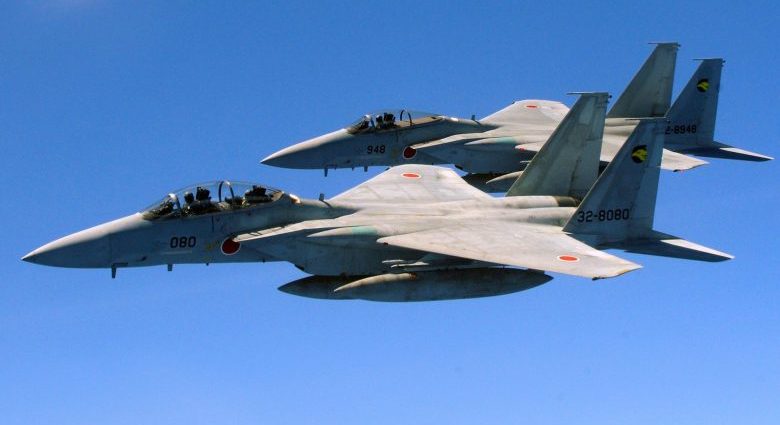Japan is considering exporting surplus jet engines from its older fighters to Indonesia, sales that would boost Tokyo’s strategic influence and revenue in the region while also bolstering Jakarta’s military modernization efforts.
This month, The Japan News reported that Tokyo may ship used F-15 engines from its Japan Air Self-Defense Force (JASDF) to help power the Indonesian Air Force’s (IDAF) aging F-16 fighters.
The report notes that the two governments have previously signed an agreement regarding the transfer of defense equipment and technologies, paving the way for the F-15 engine deal. The report also says that Japan’s 100 older F-15s will not be used in the future due to modernization difficulties.
The Japan News notes that while Japan’s Three Principles on Transfer of Defense Equipment and Technology currently limit the transfer of defense equipment for “rescue, transportation, vigilance, surveillance or minesweeping,” parts are not included in the guidelines.
It notes that exporting parts is permitted, citing the case of international joint development with parts exported to the US in the past. It also mentions that the Japanese government will present the policy at a planned meeting between the Liberal Democratic Party (LDP) and coalition partner Komeito.
The report also says that some in the LDP call for revising the current guidelines to allow for the active export of parts alongside other equipment. It also says that Japan hopes to improve bilateral relations with Indonesia and create a favorable regional security environment.
Japan’s used F-15 engines are a valuable resource that could be the foundation of practical cooperation between Indonesia and many other countries that operate F-15s and F-16s.
Ashish Dangwal notes in Eurasian Times that Japan may have to dispose of 200 viable Pratt &Whitney F100 turbofan engines extracted from decommissioned twin-engine JASDF F-15s, with exporting them to other countries seen as a potential solution.
Dangwal notes that Japan, in line with its 2022 Medium-Term Defense Program, aims to replace 100 JASDF F-15s with F-35s within the next decade at a rate of 10 aircraft a year.

He notes that 200 engines at a rate of 20 a year may be available for export or reprocessing for 16 countries that have expressed interest, including several European countries, Indonesia, Saudi Arabia, South Korea and Taiwan.
Dangwal also mentions that IHI Corporation in Japan manufactures the F100 under license, which means Japanese firms will be in charge of maintenance and support for these engines should they be transferred to third parties. That, Dangwal notes, would have positive implications for the Japanese defense and aerospace industry.
While Japan has no shortage of high-tech qualifications for jet engine manufacturing and maintenance, it may have yet to re-learn the bureaucracy, process and business of arms exports, as it has not formally engaged in such since the de facto 1967 Japanese Arms Export Ban.
In the case of Indonesia, Prashanth Parameswaran notes in an April 2020 article in The Diplomat that the IDAF has been looking to boost its capabilities, with officials frequently noting that the force doesn’t have sufficient aircraft to cover its airspace and meet its evolving security needs, including vis-à-vis China.
Stephen Burgess mentions in an April 2023 Journal of Indo-Pacific Affairs article that the IDAF operates a hodgepodge fighter force of 49 jets made in the US and Russia, including 33 F-16s, 11 Su-30s, and five Su-27s. He notes that the Su-30 is the IDAF’s primary fighter.
At the same time, the older F-16s are less capable, have limited upgrade potential and can only be effective when integrated into an air defense strategy.
Indonesia has taken steps to acquire newer aircraft, though with mixed results. Asia Times reported on Indonesia’s recent purchase of a dozen 26-year-old ex-Qatari Mirage 2000-5 jets this month as the country struggles to mobilize the resources needed to acquire newer, pricier aircraft.
The Mirages will be stationed at Pontianak’s Supadio airbase, replacing the much older Northop F5s that have long been withdrawn from service and will be used as a training and familiarization platform pending the delivery of 42 Dassault Rafale jets from France.
Indonesia planned to purchase Russia’s Su-35 but was dissuaded by US threats to impose the Countering America’s Adversaries Through Sanctions Act (CAATSA), which targets Russia, Iran and North Korea.

Asia Times reported in February 2022 that the US offered 36 F-15EX fighters to Indonesia as an alternative to the Russian fighters, but their high per-unit price and possible US restrictions on the jets’ avionics and weapons systems caused Jakarta to opt instead for the Rafales.
However, budget limitations and shifting priorities may limit the number of Rafales Jakarta ultimately buys.
Significantly, Indonesia is also a stakeholder in South Korea’s KF-21 Boramae fighter project. However, Asia Times noted in June 2022 that payment issues on Indonesia’s side have hindered its participation.
The US may also be reluctant to share critical fighter technologies with South Korea, as the latter is known for making upgraded knockoffs of US military equipment, potentially undercutting US arms sales.
Indonesia may thus be forced to keep its aging F-16s in the air out of military and financial necessity. Military Watch noted in 2019 that while the F-16’s performance may not meet the IDAF’s modernization requirements, they are valuable in paying off the US defense sector and warding off possible US sanctions for its defense dealings with Russia.
Keeping the F-16 in service with Japanese and US assistance might achieve that political aim and on a limited budget. Indonesia’s issues in modernizing its air force underscore the complicated nature of its defense partnerships.
That hedging is in line with Indonesia’s staunchly independent foreign policy, which eschews over-reliance on any one partner to avoid getting dragged into a regional conflict or being used as a battleground by external powers, but is becoming more difficult to balance in the current heated geopolitical environment.

